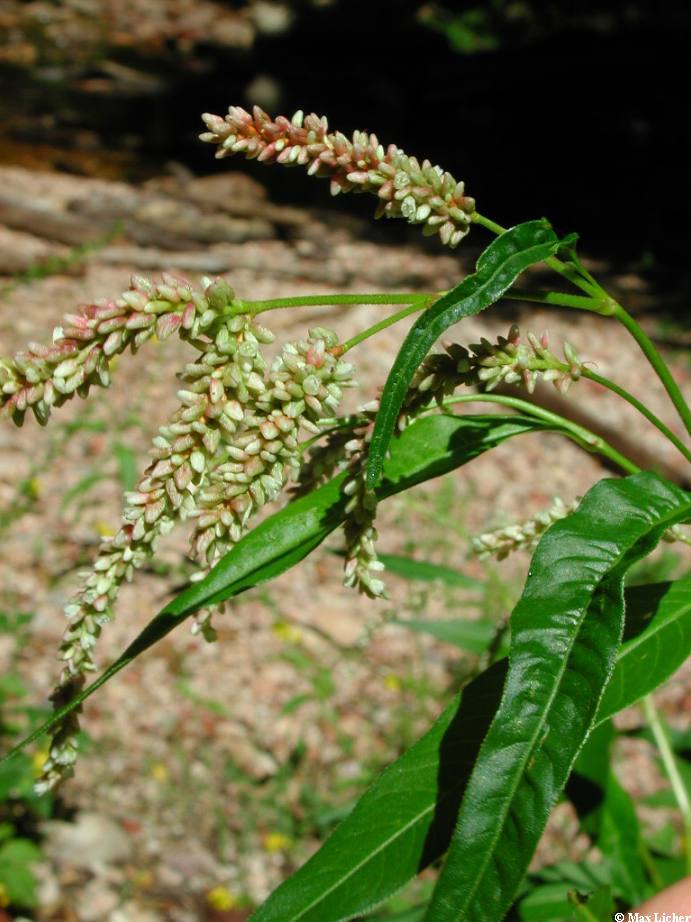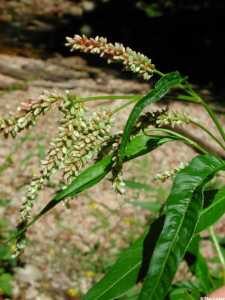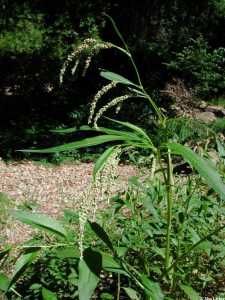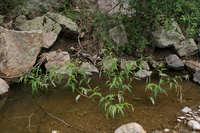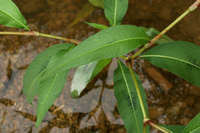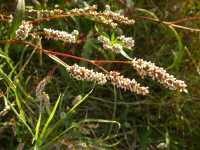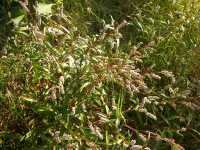Plants annual, (0.5-)1-10 dm; roots also sometimes arising from proximal nodes; rhizomes and stolons absent. Stems ascending to erect, simple or branched, scarcely ribbed, glabrous or, rarely, appressed-pubescent distally, sometimes glandular-punctate or stipitate-glandular distally. Leaves: ocrea brownish, cylindric, 4-24(-35) mm, chartaceous, base inflated, margins truncate, eciliate or ciliate with bristles to 1 mm, surface glabrous, rarely strigose, eglandular; petiole 0.1-1.6 cm, usually strigose, sometimes glabrous; blade sometimes with dark triangular or lunate blotch adaxially, narrowly to broadly lanceolate, 4-12(-22) × (0.3-)0.5-4(-6) cm, base tapering to cuneate, margins antrorsely scabrous, apex acuminate, faces strigose on main veins, glabrous or tomentose abaxially, glandular-punctate abaxially. Inflorescences mostly terminal, sometimes also axillary, mostly arching or nodding, usually uninterrupted, 30-80 × 5-12 mm; peduncle 2-25 mm, often stipitate-glandular; ocreolae usually overlapping, margins eciliate or ciliate with bristles to 0.4 mm. Pedicels ascending, 0.5-2.3 mm. Flowers 4-14 per ocreate fascicle, homostylous; perianth greenish white to pink, glabrous, not glandular-punctate or glandular-punctate with punctae mostly on tubes and inner tepals, scarcely accrescent; tepals 4(-5), connate ca. 4- 3 their length, obovate to elliptic, 2.5-3 mm, veins prominent, those of 2 or 3 outer tepals prominently bifurcate distally, anchor-shaped, margins entire, apex obtuse to rounded; stamens 5-6, included; anthers pink or red, elliptic; styles 2(-3), connate at bases. Achenes included or apex exserted, brown to black, discoid or, rarely, 3-gonous, 1.5-3.2 × 1.6-3 mm, shiny or dull, smooth. 2n = 22.
Flowering (Apr-)Jul-Nov. Moist places, roadsides, floodplains, waste places, cultivated fields; 0-1500(-1800) m; Greenland; St. Pierre and Miquelon; Alta., B.C., Man., N.B., Nfld. and Labr., N.W.T., N.S., Ont., P.E.I., Que., Sask., Yukon; Ala., Alaska, Ariz., Ark., Calif., Colo., Conn., Del., D.C., Fla., Ga., Idaho, Ill., Ind., Iowa, Kans., Ky., La., Maine, Md., Mass., Mich., Minn., Miss., Mo., Mont., Nebr., Nev., N.H., N.J., N.Mex., N.Y., N.C., N.Dak., Ohio, Okla., Oreg., Pa., R.I., S.C., S.Dak., Tenn., Tex., Utah, Vt., Va., Wash., W.Va., Wis., Wyo.; Mexico; South America; Europe; Asia; Africa; Pacific Islands (New Zealand).
Persicaria lapathifolia is a morphologically variable complex with more than two-dozen infraspecific taxa described in the New World and Old World. An allozyme study by L. L. Consaul et al. (1991) did not support recognition of elements often referred to Polygonum lapathifolium var. salicifolium or P. scabrum, which are synonymized here. Yang J. and Wang J. W. (1991) reached a similar conclusion regarding var. salicifolium and P. nodosum based on their morphometric analysis.
The Keres, Navajo, and Potawatomi prepared medicinal infusions with Persicaria lapathifolia, and the Zuni used decoctions made from the plants as cathartic and emetic drugs (D. E. Moerman 1998).
Frequent in low and wet grounds throughout the state, preferring the low borders of streams. It is also found in cultivated and fallow fields.
Duration: Annual
Nativity: Native
Lifeform: Forb/Herb
General: Annual herb, 10-100 cm tall, from a short taproot and much longer, abundant fibrous roots; stems ascending to erect, with the top of the plant usually nodding; herbage glabrous or occasionally glandular or appressed-hairy near the top.
Leaves: Alternate along the stems, on petioles 1-16 mm long; at the base of each leaf is a sheathlike structure called an ocrea which is composed of fused stipules and wraps around the stem; ocrea 4-35 mm long, with a smooth or ciliate margin; leaf blades linear-lanceolate to lanceolate, 5-20 cm long, with a prominent white midvein on upper surface and often a red or purple triangular or crescent-shaped blotch near the middle of the leaf; upper surface glandular-punctate and the lower surface hairless or tomentose.
Flowers: Pink to greenish-white, in short dense spikes, 3-8 cm long, these nodding at branch tips; flowers with 4 or 5 petal-like tepals, these greenish-white to pink and fused at the base.
Fruits: Achenes 2-3 mm long, usually lens-shaped but occasionally 3-angled, smooth, brown to black, and shiny or dull.
Ecology: Found in moist to wet soils next to streams and lakes, or occasionally in wet meadows, from 1,000-7,500 ft (305-2286 m); flowers April-October.
Distribution: Throughout N. Amer., in every state in the U.S.; south to S. Amer.; throughout the world on every continent.
Notes: Distinctive with its relatively large size; linear-lanceolate leaves that are much larger than other species in the genus and often have a reddish blotch in the center; pale pinkish flowers in nodding spikes at the tops of the stems, and usually a few spikes in the leaf axils as well; the flower spikes do not necessarily nod or droop until the flowers are fully mature; this species is fairly common in moist soils, especially along low-elevation rivers, but note that it not aquatic (it is rooted in soil and its base is usually not under water). Look for it under Polygonum lapathifolium in many texts.
Ethnobotany: Used ceremonially; for fever; and as an emetic and purgative.
Etymology: Persicaria is derived from the Latin persica, peach, and aria, pertaining to, alluding to the leaf shape of some species in the genus; lapathifolium is from lapathium, the Latin word for sorrel or dock, so it means with leaves like sorrel or dock.
Synonyms: Polygonum lapathifolium, Persicaria incarnata, Persicaria tomentosa, Polygonum incanum, Polygonum incarnatum, Polygonum lapathifolium subsp. pallidum, Polygonum lapathifolium var. incanum, Polygonum lapathifolium var. nodosum
Editor: SBuckley 2010, FSCoburn 2015, AHazelton 2017
Erect annual to 15 dm, or occasionally prostrate; lvs variable, commonly lanceolate and acuminate, often tomentose beneath; ocreae entire or merely lacerate, not fringed-ciliate; summit of the peduncle and axis of the infl glabrous to densely glandular; racemes numerous, nodding, 1-5 cm; ocreolae ovate; perianth rose, white, or green, 3-4 mm at maturity, 4(5)-lobed to below the middle, the outer lobes becoming obovate, strongly 3-nerved, each nerve divided at the summit into 2 recurved branches; achene lenticular, flat or concave on both sides, 1.7-3.2 mm, 75-90% as wide; 2n=22. Probably both native and intr., chiefly in moist soil, nearly throughout temperate N. Amer., and in the Old World. (P. scabrum; P. tomentosum)
Gleason, Henry A. & Cronquist, Arthur J. 1991. Manual of vascular plants of northeastern United States and adjacent Canada. lxxv + 910 pp.
©The New York Botanical Garden. All rights reserved. Used by permission.


